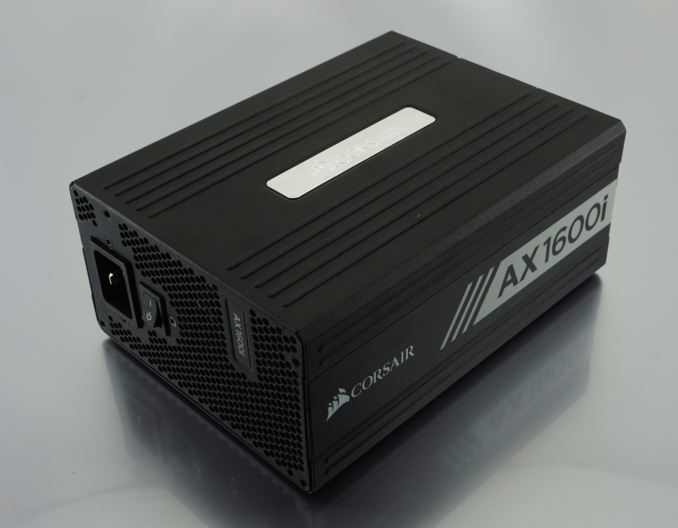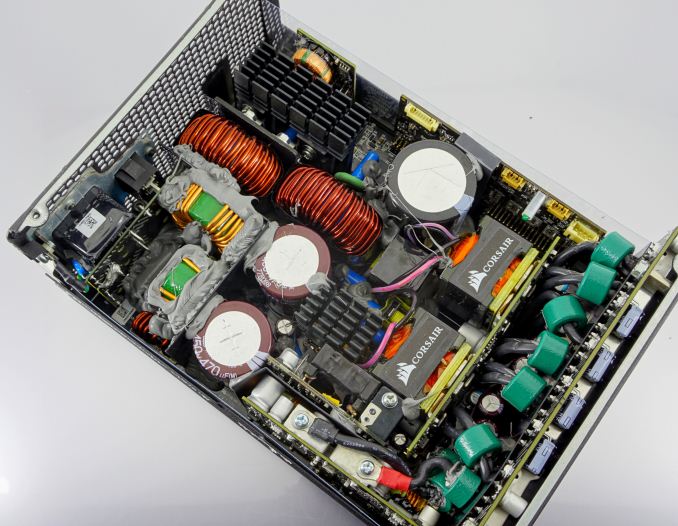The Emperor of Efficiency: Corsair's AX1600i PSU Rules Alone (Review)
by E. Fylladitakis on April 18, 2018 9:30 AM ESTConclusion
Corsair's intent behind the creation of the AX1600i was to create a product that is technologically and qualitatively superior than anything else in the consumer's market, with little regard for its production cost and, ultimately, the retail price. It is the kind of product aiming to please just a select few who want to build top-tier gaming systems or workstations regardless of the monetary cost.
Technologically, the AX1600i undoubtedly is the most advanced PSU that is currently available to consumers. The Gallium Nitride (GaN) parts are smaller, lighter, and significantly more efficient than their classic silicon-based counterparts. Their use allowed Flextronics (and ultimately Corsair) to design a platform that combines better overall performance and higher output into a smaller chassis. The end result is a PSU that is no larger than most 800W designs and yet is capable of delivering twice that power output without flinching. GaN parts are greatly more expensive than their silicon-based counterparts but the final product's cost was partially offset by the reduction in size and cooling requirements, allowing Corsair to maintain the price of the AX1600i at relatively reasonable levels.
The overall performance of the AX1600i is incomparable to that of classic PSU designs. Even the top tier models from other known manufacturers would have a hard time competing with the AX1600i on a single performance aspect - let alone every aspect. The power quality is textbook, with barely any voltage ripple appearing on any of the lines and under any load, while the voltage regulation is practically ideal. The very high electrical efficiency of the platform not only minimizes energy waste but also allows the PSU to operate very quietly and maintain low internal temperatures even when heavily loaded. Its very high quality parts are almost completely unaffected by environmental factors, ensuring that the AX1600i will perform 100% even in harsh environments. Taken altogether this means that the AX1600i has no peer; simpy put, its performance is unparalleled.
Corsair's flagship combines the best possible overall performance with exceptional quality parts, fashioning the best consumer PSU that money can buy. However, the AX1600i's true enemy is itself. With a price tag of $500 and a power output of 1600 Watts, the PSU is both preposterously expensive compared to regular designs and has a power output that will be vastly oversized for almost every kind of user. Only a system with a very powerful CPU and at least four top-tier graphics cards will be able to reasonably load an AX1600i, and these systems are quickly becoming a relic as NVIDIA scale back on SLI & CrossFire support. Instead we'd be looking at edge cases such as heavily overclocked systems with a smaller number of video cards, or someone who needs a lot of Titan Vs for productivity purposes.
Still, Corsair's move to GaN components signifies a very important milestone, as it is very likely that we will be seeing them implemented in less powerful units in the near future. They will be especially useful in SFX designs, as they will be able to deliver a high power output very efficiently, allowing the creation of quiet SFX units for living room gaming systems.












39 Comments
View All Comments
Belldandy - Wednesday, April 18, 2018 - link
For most people the Seasonic Prime Ultra Titanium is the best PSU they will ever need.IBM760XL - Wednesday, April 18, 2018 - link
That's the one I want to buy next. I was curious if this would match it at my typical 100-200W loads, despite being so much lower on its efficiency curve than a 600-700W Seasonic Titanium model. But the price is pretty eye-watering. The environmentalist in me will be satisfied by the Prime Ultra.Still, glad to see technological progress being made. Put the new technology in a 700W PSU in a few years, with a bit more economy of scale, and I'd probably buy it.
SonicIce - Thursday, April 19, 2018 - link
Strange the Prime series was made in Taiwan (the only PSU I've ever seen not made in China), but the new Prime Ultra series is made in China. Hmmm.rtho782 - Thursday, April 19, 2018 - link
My AX1500i died a month ago, and I got one of these as a warranty replacement :)It's a very nice PSU, even though it's still way overkill for me really. My system never draws more than about 750W. I am also very happy that it's a little shorter than the AX1500i.
rtho782 - Thursday, April 19, 2018 - link
> The side stickers can be (permanently) replaced with those supplied with the unit's bundled items.Are you sure? Mine were magnetic.
nowwhatnapster - Friday, April 20, 2018 - link
Can confirm, they are magnetic. It's a sleek cover up. Not permanent at all, which is a good thing IMOCheapSushi - Friday, April 20, 2018 - link
I dream about these designs getting smaller. Imagine this in SFX-L. As all our systems get more efficiency, smaller scaled, etc, the ATX PSU's are starting to seem like relics. Not the wattage, but the volume of the thing itself. SFX and SFX-L I hope become the de facto "standard" size. GaN components, like mentioned, is the step to that. I know people are making snide comments, but thank you Corsair for actually doing something to push PSU designs. A future SFX-L version would be amazing.Ninjawithagun - Thursday, May 10, 2018 - link
There is an SFX-L 800W Titanium PSU made by Silverstone:https://www.amazon.com/SilverStone-Technology-SX80...
Ninjawithagun - Thursday, May 10, 2018 - link
No need to replace my AX1500i Titanium PSU, but it's good to know Corsair has not fallen asleep ;-)